
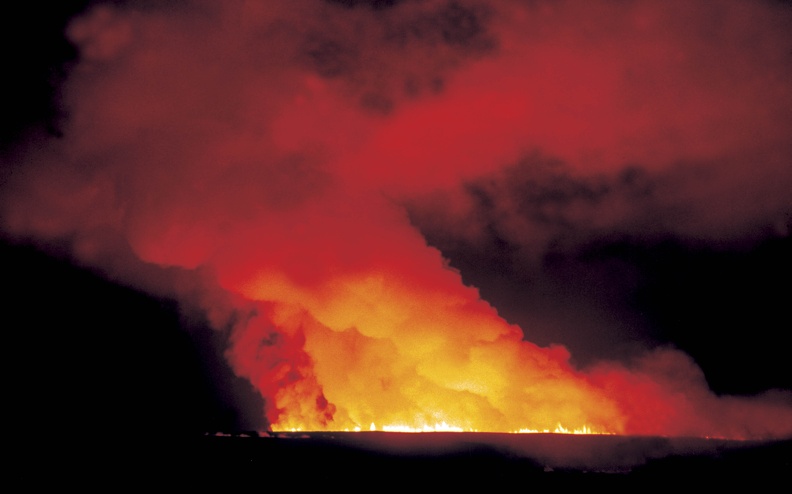 Curtain of Fire
Curtain of Fire
Meanwhile, lava broke out of the base of this side of the cinder cone forming the Bonito Flow all around you. The lava pooled, trapped by surrounding older volcanoes, and accumulated to perhaps 100 feet (30 m) thick during at least three separate flows. On the opposite of the cone, lava flowed more than six miles (10 km), filling a narrow valley. When the volcano coughed out its last cinders – after several months or perhaps several years – they were colored by the oxidation of iron in the magma. Similar to the way metal rusts, the magma came in contact with water-rich gasses emitted during the final stages of the eruption. These red cinders rim the top of the cone.
- Eruption date: sometime between 1040 and 1100
- Height: 1,000 feet (305 m)
- Elevation at summit: 8,029 feet (2,447 m)
- Diameter at base: 1 mile (1.6 km)
- Diameter at top: 2,250 feet (868 m) from rim to rim
- Depth of crater: 300 feet (91.4 m)
- Extruded material: approximately 1 billion tons
- Extent of ashfall: approximately 800 square miles (2,072 sq km)
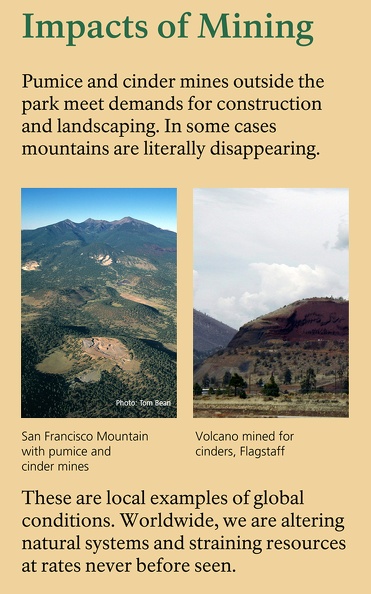 mining
mining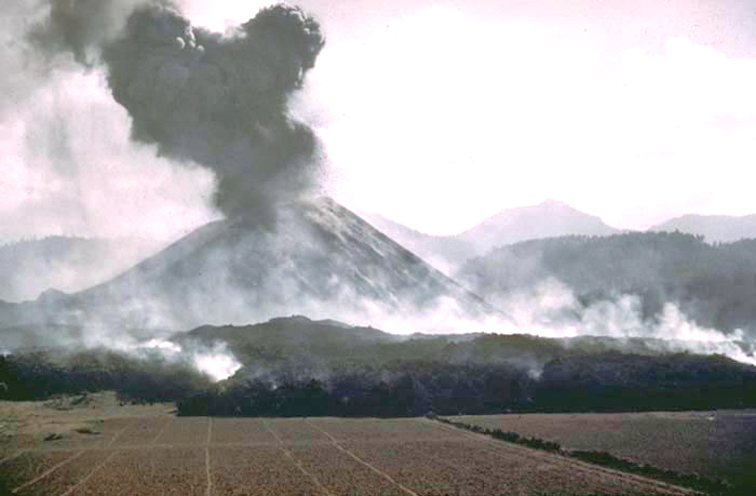 Paricutin
Paricutin
Volcanic eruptions may seem destructive but they are among the beneficial forces of a living planet: forces that build mountains, create oceans, and provide for live. Only when our planet has finished cooling will there be no volcanoes. Then, Earth will be a dead planet much like Mars. The eruption of Parícutin in Mexico, 1943, is considered the modern day equivalent of the Sunset eruption.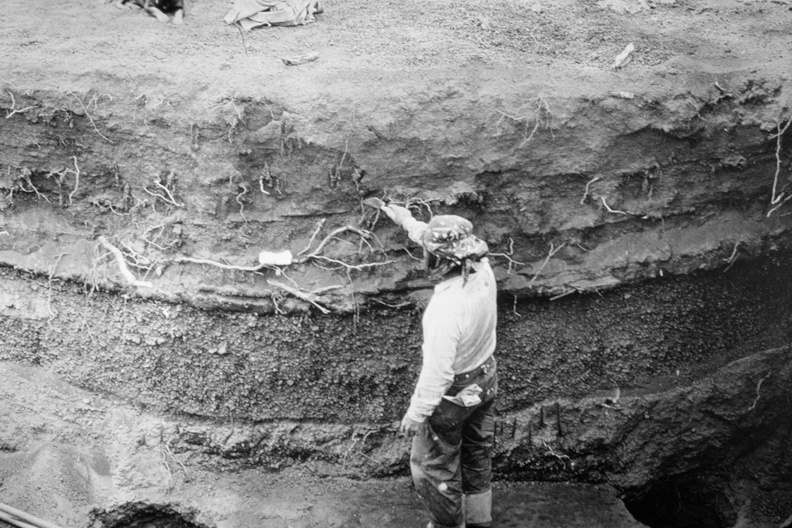 Dating Debates
Dating Debates What if scientists always agreed, never argued, or changed their minds?
Clues in Buried Homes: Until archeologists discovered Sinagua-style pithouses beneath the cinders, scientists did not suspect Sunset Crater was so young. Knowing the age of the pithouses from tree-ring dates and pottery types found in these homes, they concluded the eruption occurred after 1046 and before 1071.
What if scientists always agreed, never argued, or changed their minds?
Clues in Buried Homes: Until archeologists discovered Sinagua-style pithouses beneath the cinders, scientists did not suspect Sunset Crater was so young. Knowing the age of the pithouses from tree-ring dates and pottery types found in these homes, they concluded the eruption occurred after 1046 and before 1071.
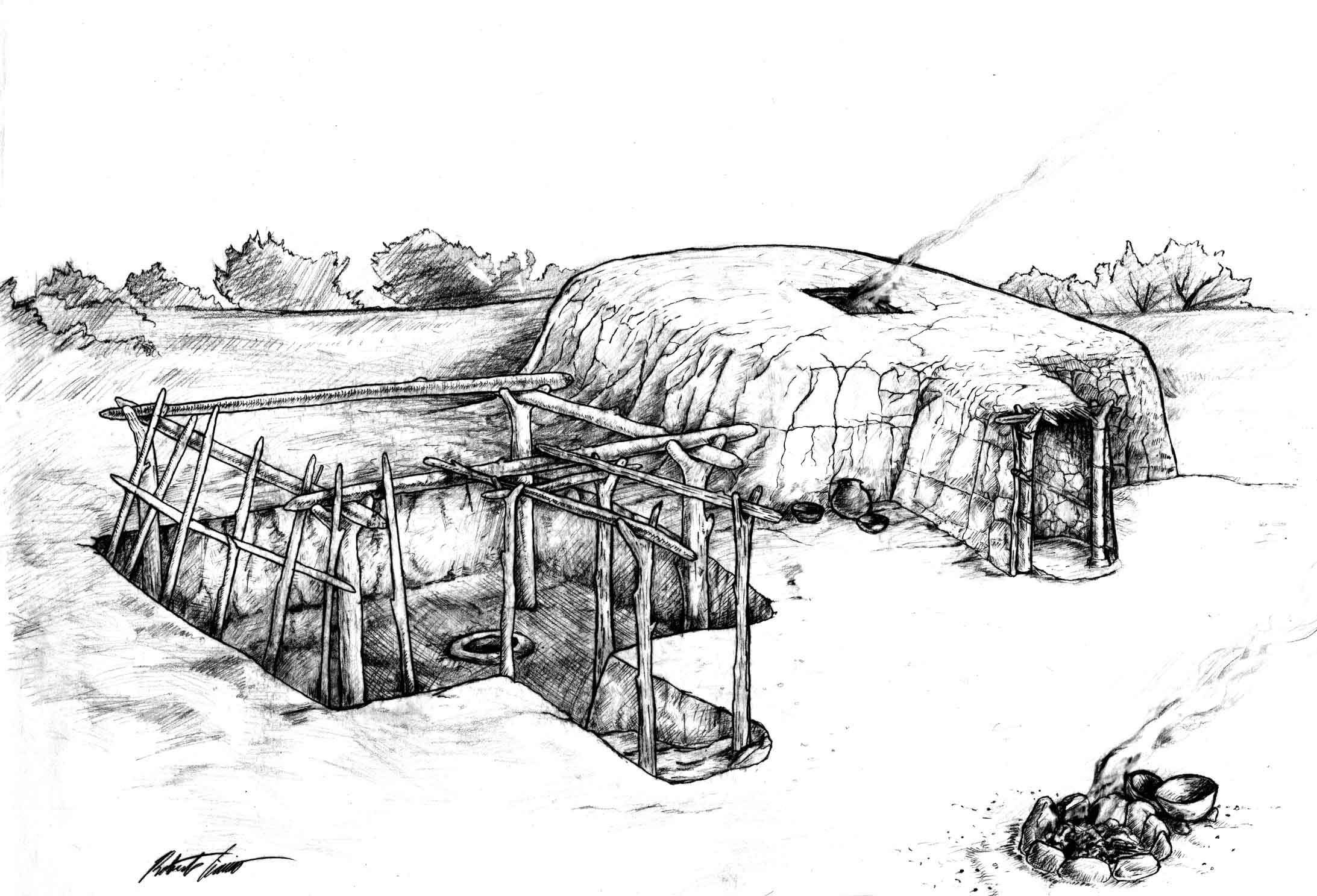 Patterns in Tree Rings: Trees near an erupting volcano, if they are injured but continue to live, show a growth disturbance in their rings. Based on the growth pattern seen in three wood specimens from nearby Wupatki Pueblo, scientists hypothesized that the eruption occurred between the growing seasons of 1064 and 1065. But, this evidence is limited and inconclusive.
Magnetism in Rocks: Geologists have taken more than 100 core samples from the Sunset Crater lava flows for paleomagnetic studies. Using both paleomagnetic dating and stratigraphic evidence, geologists currently restrict the Sunset eruption to sometime between 1040 and 1100.
Patterns in Tree Rings: Trees near an erupting volcano, if they are injured but continue to live, show a growth disturbance in their rings. Based on the growth pattern seen in three wood specimens from nearby Wupatki Pueblo, scientists hypothesized that the eruption occurred between the growing seasons of 1064 and 1065. But, this evidence is limited and inconclusive.
Magnetism in Rocks: Geologists have taken more than 100 core samples from the Sunset Crater lava flows for paleomagnetic studies. Using both paleomagnetic dating and stratigraphic evidence, geologists currently restrict the Sunset eruption to sometime between 1040 and 1100.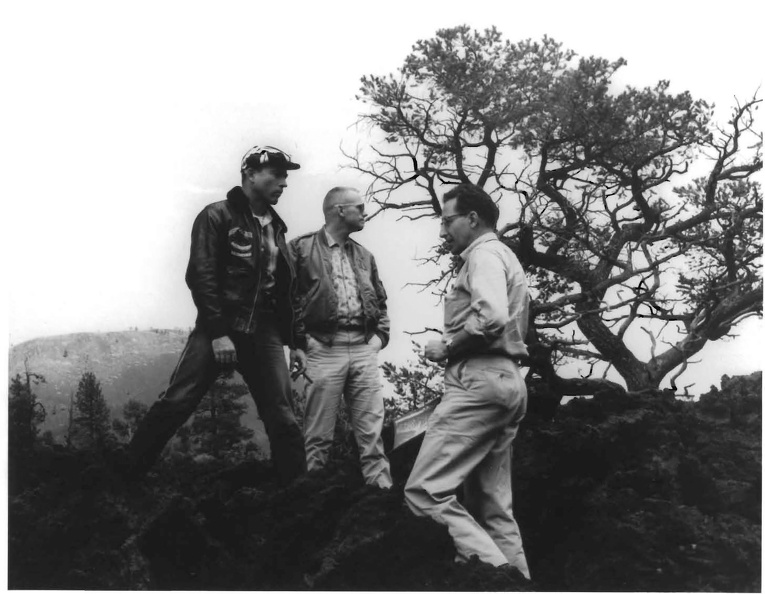 Geology Briefings, Bonito Lava Flow, 1964
Geology Briefings, Bonito Lava Flow, 1964
Description: John Young (left), Neil Armstrong (center), and Branch of Astrogeology trainer discussing the geology of the Bonito Lava Flow in Sunset Crater Volcano National Monument in 1964. One of the Apollo crew's tasks was the geological exploration of the lunar surface - the Bonito Lava Flow was chosen for training because prior to the first successful landing on the moon, the rough lava-flow surface was thought to be a good proxy for the lunar surface. Collection: Sunset Crater Volcano National Monument.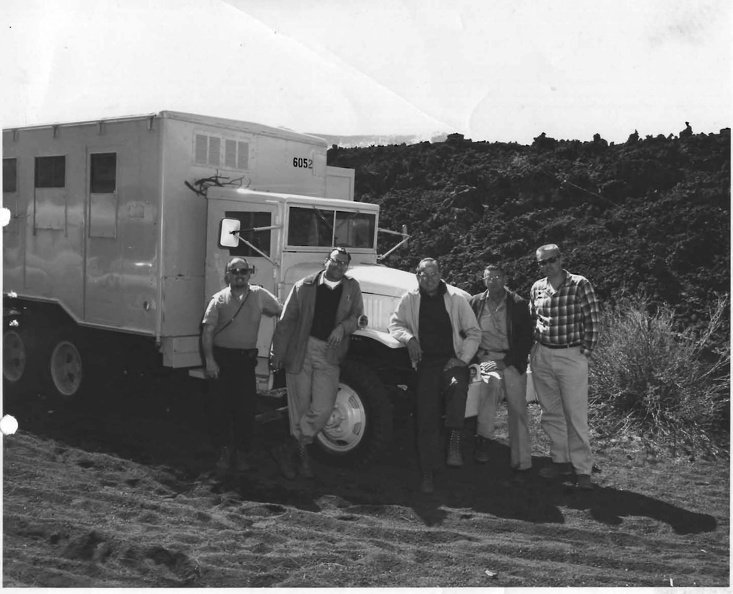 Preparing to Test Equipment, 1964
Preparing to Test Equipment, 1964
Description: In 1964, the first field tests using NASA space suits took place on the Bonito Lava Flow and the deep bordering cinder. Here, the crew poses alongside the equipment truck, with the Bonito Lava Flow behind them. Collection: Sunset Crater Volcano National Monument.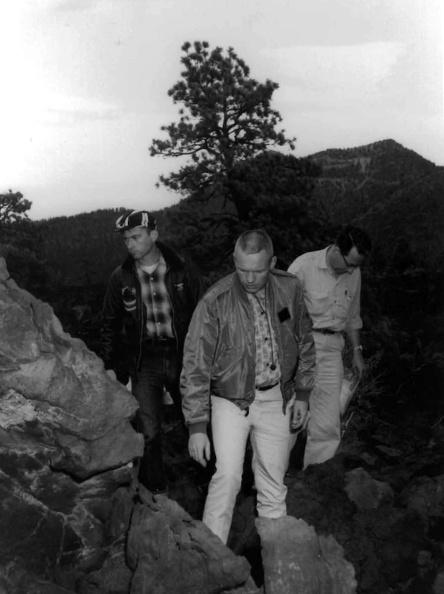 Exploring the Bonito Lava Flow, 1964
Exploring the Bonito Lava Flow, 1964
Description: Apollo astronauts John Young (left) and Neil Armstrong (center) with a Branch of Astrogeology trainer exploring the Bonito Lava Flow in 1964. Prior to the first successful moon landing, scientists thought the rough lava-flow surface was likely how the surface of the moon would be. Collection: Sunset Crater Volcano National Monument.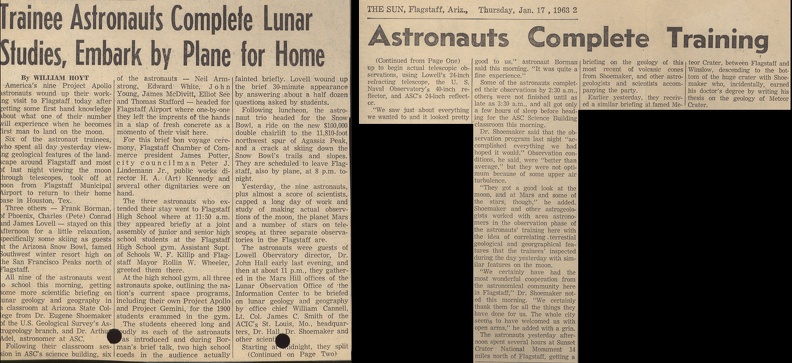 "Trainee Astronauts Complete Lunar Studies, Embark by Plane for Home"
"Trainee Astronauts Complete Lunar Studies, Embark by Plane for Home"
Description: A 1963 newspaper clipping tells of the adventures of the "New Nine" at Sunset Crater and Meteor Crater. The experience was only the beginning of the Apollo training at Sunset Crater Volcano National Monument. Collection: Sunset Crater Volcano National Monument.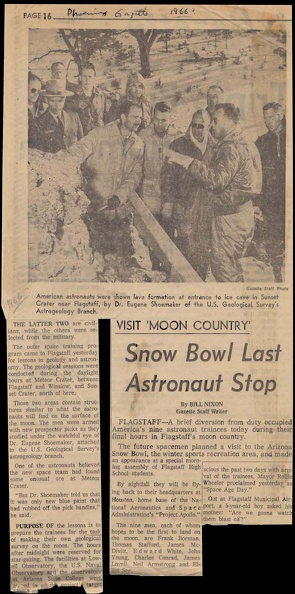 "Snow Bowl Last Astronaut Stop"
"Snow Bowl Last Astronaut Stop"
Description: A newspaper clipping from 1963 (the handwritten date is incorrect) picturing the "New Nine" at Sunset Crater Volcano National Monument's Ice Cave. Collection: Sunset Crater Volcano National Monument.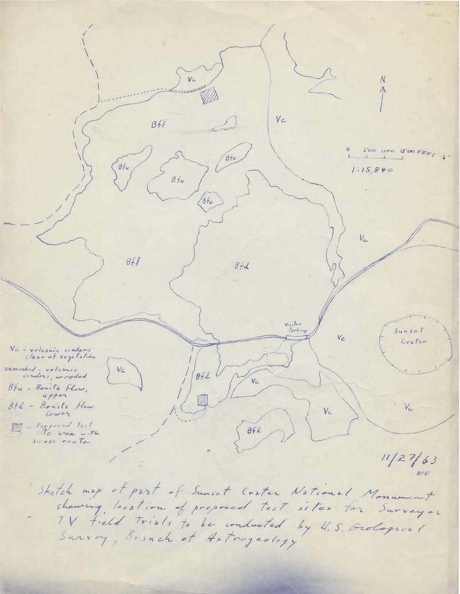 1963 Map of the Surveyor Test Locations
1963 Map of the Surveyor Test Locations
Description: 1963 hand-drawn map of the Surveyor test locations. Collection: Sunset Crater Volcano National Monument.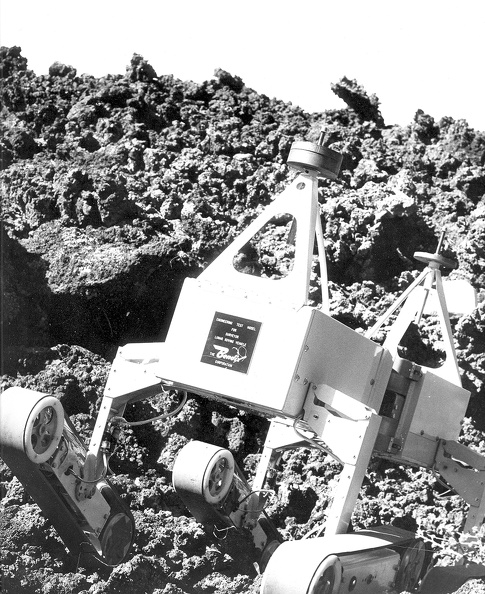 Surveyor Lunar Rover Prototype
Surveyor Lunar Rover Prototype
Description: In 1964, two lunar rover prototypes were tested on the Bonito Lava Flow to determine which had the best trafficability on the lava. The lava tore the tread from the Bendix prototype (shown here), and both prototypes were ultimately dropped because of poor field-test results. Collection: USGS Open-File Report 2005-1190, Figure 009.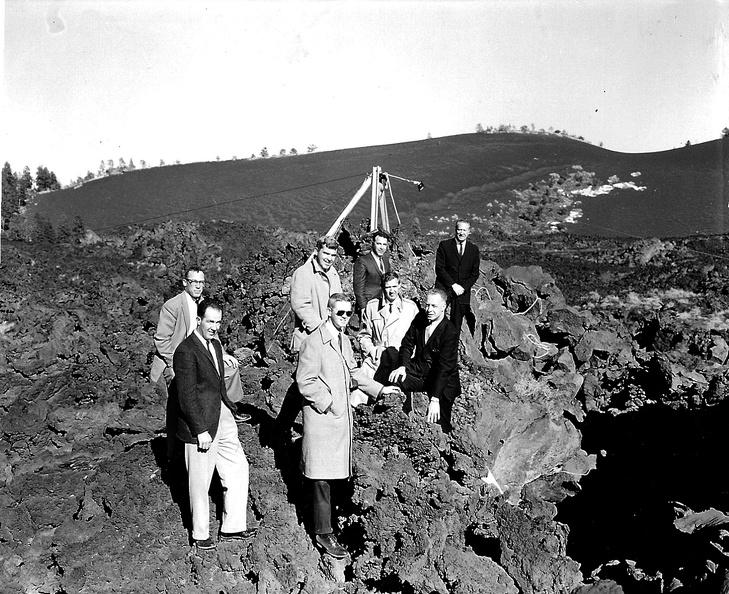 Testing the Surveyor Camera System
Testing the Surveyor Camera System
Description: In 1964, the camera system ultimately used on during the Surveyor missions was tested on the Bonito Lava Flow in Sunset Crater Volcano National Monument. The lava flow was selected for the test because it was thought that it would reflect light the same way as expected on the lunar surface. Collection: USGS Open-File Report 2005-1190, Figure 013; USGS photo, P879B, F651112.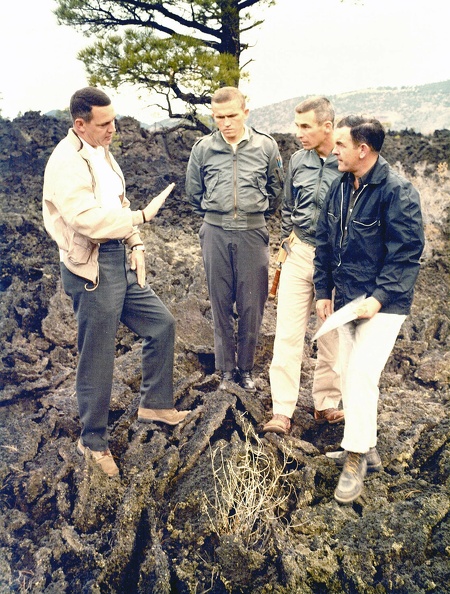 Geology Training on the Bonito Lava Flow, 1964
Geology Training on the Bonito Lava Flow, 1964
Description: Astronauts C.C. Williams, Frank Borman, and Gene Cernan with Branch of Astrogeology trainer Dale Jackson on the Bonito Lava Flow in 1964. Collection: USGS Open-File Report 2005-1190, Figure 014e; NASA photo S-64-23729, 30 April 1964.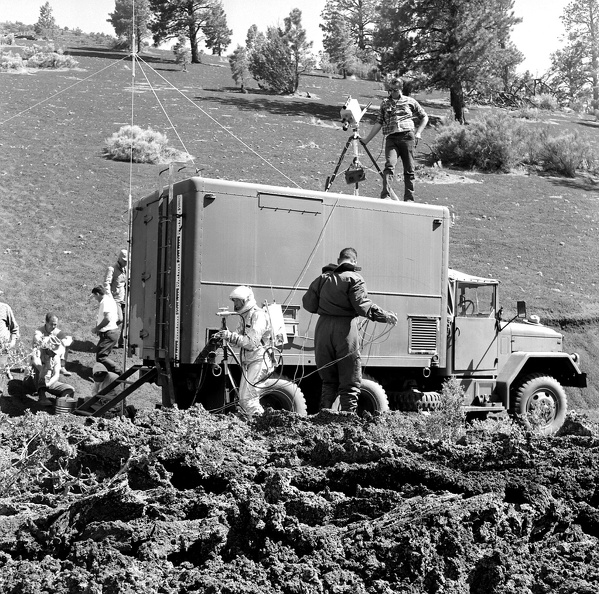 Testing the First Spacesuits, 1964
Testing the First Spacesuits, 1964
Description: The first spacesuits were tested in Sunset Crater Volcano National Monument in 1964, but not by astronauts. Although members of the Apollo crew were present, the suits were too small for any of them, so the actual tests were done by Gene Shoemaker, Jerry Harbor, and Gene Phillippi, all of the Branch of Astrogeology, which later became NASA. Collection: USGS Open-File Report 2005-1190, Figure 016a.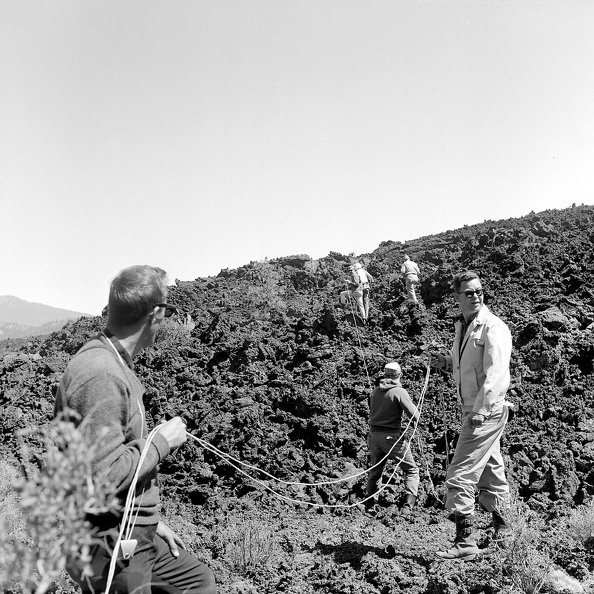 Testing Suits on the Bonito Lava Flow
Testing Suits on the Bonito Lava Flow
Description: One test of the suits involved climbing on the Bonito Lava Flow, where sharp stones and loose footing were both hazards. Collection: USGS Open-File Report 2005-1190, Figure 016b.